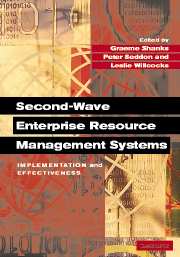Book contents
- Frontmatter
- Contents
- List of Contributors
- Introduction: ERP – The Quiet Revolution?
- Part I Implementation and Effectiveness: Overview
- Part II From Risks to Critical Success Factors
- 5 Enterprise System Implementation Risks and Controls
- 6 Risk Factors in Enterprise-wide/ERP Projects
- 7 A Framework for Understanding Success and Failure in Enterprise Resource Planning System Implementation
- 8 Critical Success Factors Revisited: A Model for ERP Project Implementation
- 9 Offsetting ERP Risk through Maintaining Standardized Application Software
- Part III From Learning to Knowledge
- Part IV Cultural Aspects of Enterprise Systems
- Part V Future Directions
- Index
- References
9 - Offsetting ERP Risk through Maintaining Standardized Application Software
from Part II - From Risks to Critical Success Factors
Published online by Cambridge University Press: 05 February 2012
- Frontmatter
- Contents
- List of Contributors
- Introduction: ERP – The Quiet Revolution?
- Part I Implementation and Effectiveness: Overview
- Part II From Risks to Critical Success Factors
- 5 Enterprise System Implementation Risks and Controls
- 6 Risk Factors in Enterprise-wide/ERP Projects
- 7 A Framework for Understanding Success and Failure in Enterprise Resource Planning System Implementation
- 8 Critical Success Factors Revisited: A Model for ERP Project Implementation
- 9 Offsetting ERP Risk through Maintaining Standardized Application Software
- Part III From Learning to Knowledge
- Part IV Cultural Aspects of Enterprise Systems
- Part V Future Directions
- Index
- References
Summary
Introduction
Enterprise Resource Planning (ERP) systems purport to integrate the complete range of business processes and functions into a single information and technology infrastructure. By 2003 ERP software was highly configurable, and, while noting the qualifications made in earlier chapters, technically it went a long way towards accommodating the diverse needs of users across most sectors of the economy. This development has, in fact, happened over a long period. Though the breadth and tight integration of ERP has only become available in recent years, ERP have a pedigree in large, packaged application software that has been in widespread use since the 1970s (Klaus, Rosemann, and Gable, 2000).
The market for ERP products and services sustains a significant segment of the software and services industry, consisting of several of the largest software firms as well as the world's largest management consulting companies. Related annual revenues were expected to exceed $20 billion by 2002, approximately half vendor service revenue and half vendor license revenue (Gartner Group, 1999). Most multinational companies as well as many public sector organizations, have adopted ERP and increasingly small and medium-sized enterprises have been following suit. Indeed, by 2003 ERP formed the backbone of many application architectures and were being extended into developments such as e-business and e-government (see also Chapters 4 and 18).
- Type
- Chapter
- Information
- Second-Wave Enterprise Resource Planning SystemsImplementing for Effectiveness, pp. 220 - 238Publisher: Cambridge University PressPrint publication year: 2003
References
- 1
- Cited by



